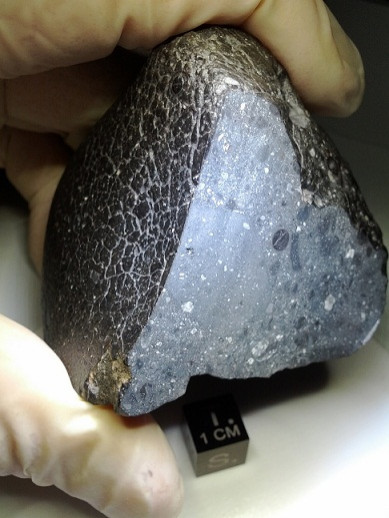Mars Water-Rich Meteorite Found In Sahara Desert Is First From Red Planet Surface

Scientists say that a meteorite found in the Sahara Desert in 2011 may be the first space rock that’s come to us from the Martian surface and contains more water than any other piece of the Red Planet that has fallen to Earth.
The meteorite, with a formal name of Northwest Africa (NWA) 7034 and nicknamed Black Beauty, weighs a mere 11 ounces but is making big waves in the scientific community.
"The contents of this meteorite may challenge many long-held notions about Martian geology," NASA administrator John Grunsfeld said in a statement on Thursday. "These findings also present an important reference frame for the Curiosity rover as it searches for reduced organics in the minerals exposed in the bedrock of Gale Crater."
Researchers from the University of New Mexico, the University of California San Diego, China’s Sun Yat-Sen University and the Carnegie Institution of Washington published an analysis of the meteorite in the journal Science on Thursday.
The scientists concluded that the meteorite is about 2.1 billion years old, making it older than most other Martian meteorites discovered on Earth. The date the meteorite formed is also close to the beginning of the most recent of Mars’ geological ages, the Amazonian era.
"We now have insight into a piece of Mars' history at a critical time in its evolution,” NASA scientist Mitch Schulte said in a statement Thursday.
NWA 7034 also differs from other kinds of Martian meteorites in composition. It’s made mostly of basalt, a type of rock that forms when lava rapidly cools. The kind of basalt the scientists found in the rock is similar to basalt found on the Martian crust or upper mantle, according to the latest data culled from NASA’s Mars rovers and orbiters.
“This composition is common for lunar samples, but not from other Martian meteorites,” says study coauthor and Carnegie researcher Andrew Steele.
The large amount of water in Black Beauty -- more than 10 times the amount found in any previous Mars-derived meteorite -- may be the result of its interaction with water at the surface of the Red Planet. Traces of an ancient sea, perhaps?
NWA 7034 also contains a diverse collection of oxygen isotopes, possibly picked up by interactions with the Martian atmosphere.
"This unique meteorite tells us what volcanism was like on Mars 2 billion years ago,” lead author and University of New Mexico scientist Carl Agee said in a statement. “It also gives us a glimpse of ancient surface and environmental conditions on Mars that no other meteorite has ever offered."
SOURCE: Agee et al. “Unique Meteorite from Early Amazonian Mars: Water-Rich Basaltic Breccia Northwest Africa 7034.” Science published online 3 January 2013.
© Copyright IBTimes 2025. All rights reserved.





















